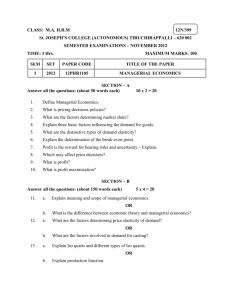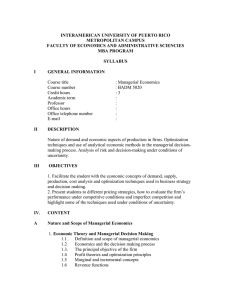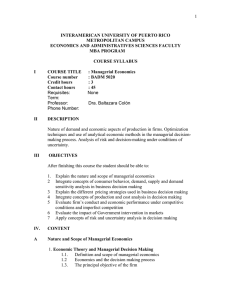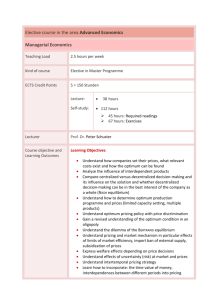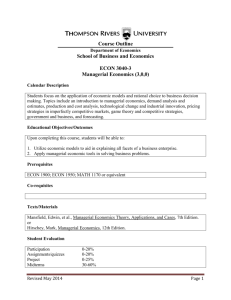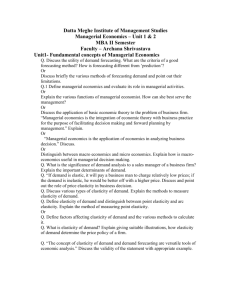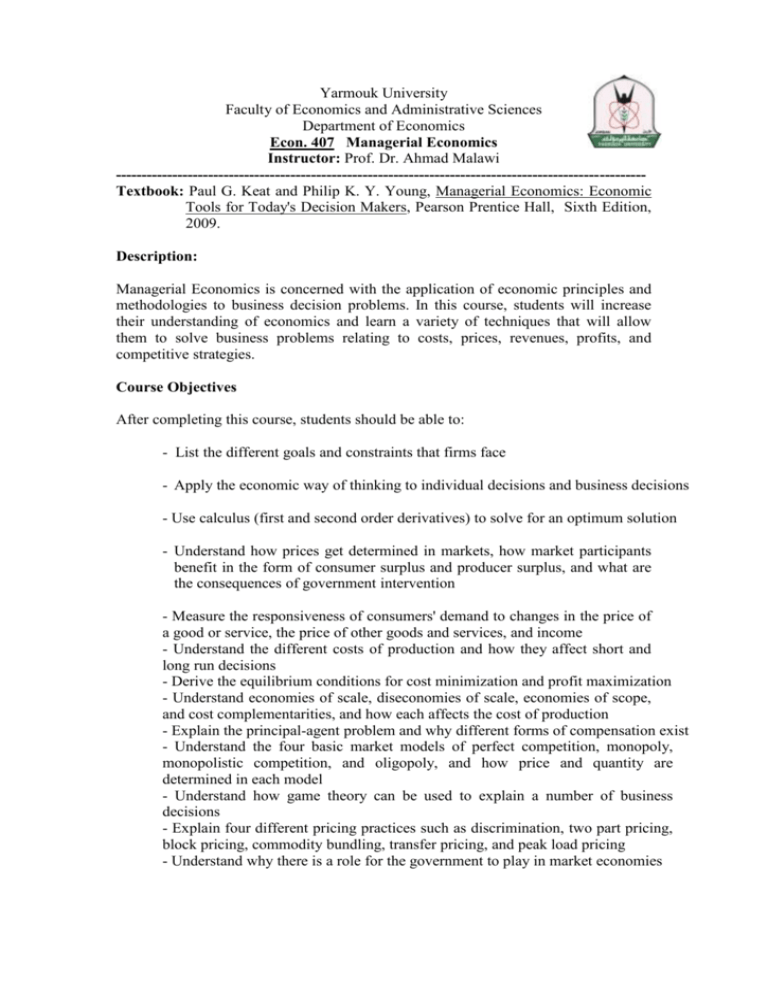
Yarmouk University
Faculty of Economics and Administrative Sciences
Department of Economics
Econ. 407 Managerial Economics
Instructor: Prof. Dr. Ahmad Malawi
------------------------------------------------------------------------------------------------------Textbook: Paul G. Keat and Philip K. Y. Young, Managerial Economics: Economic
Tools for Today's Decision Makers, Pearson Prentice Hall, Sixth Edition,
2009.
Description:
Managerial Economics is concerned with the application of economic principles and
methodologies to business decision problems. In this course, students will increase
their understanding of economics and learn a variety of techniques that will allow
them to solve business problems relating to costs, prices, revenues, profits, and
competitive strategies.
Course Objectives
After completing this course, students should be able to:
- List the different goals and constraints that firms face
- Apply the economic way of thinking to individual decisions and business decisions
- Use calculus (first and second order derivatives) to solve for an optimum solution
- Understand how prices get determined in markets, how market participants
benefit in the form of consumer surplus and producer surplus, and what are
the consequences of government intervention
- Measure the responsiveness of consumers' demand to changes in the price of
a good or service, the price of other goods and services, and income
- Understand the different costs of production and how they affect short and
long run decisions
- Derive the equilibrium conditions for cost minimization and profit maximization
- Understand economies of scale, diseconomies of scale, economies of scope,
and cost complementarities, and how each affects the cost of production
- Explain the principal-agent problem and why different forms of compensation exist
- Understand the four basic market models of perfect competition, monopoly,
monopolistic competition, and oligopoly, and how price and quantity are
determined in each model
- Understand how game theory can be used to explain a number of business
decisions
- Explain four different pricing practices such as discrimination, two part pricing,
block pricing, commodity bundling, transfer pricing, and peak load pricing
- Understand why there is a role for the government to play in market economies
Course Outline
Module 1: The Fundamentals of Managerial Economics
1.
2.
3.
4.
5.
6.
7.
Goals and Constraints
The Nature and Importance of Profits
Understanding Incentives
Understanding Markets
Time and Value of Money
Marginal Analysis
Basic Calculus: The Calculus of Optimization
Module 2: Demand and Supply
1. Demand
2. Consumer Surplus
3. Supply
4. Producer Supply
5. Market Equilibrium
6. Price Ceilings and Price Floors
7. Comparative Statics: Changes in Demand and Supply
8. Price Elasticity of Demand
9. Price Elasticity, Total Revenue, and Marginal Revenue
10. Factors Affecting Price Elasticity
11. Cross Price Elasticity
12. Income Elasticity of Demand
13. Other Elasticities
14. Elasticities for Nonlinear Demand Functions
Module 3: Costs of Production and the Organization of the Firm
1.
2.
3.
4.
5.
6.
7.
8.
9.
The Production Function
Profit-Maximizing Input Usage
Isoquants and Isocosts
Cost Minimization and Optimal Input Substitution
The Cost Function
Long-run Costs and Economies of Scale
Multiple Cost Functions and Economies of Scope
Methods of Procuring Inputs and Optimal Input Procurement
Managerial Compensation and the Principal-Agent Problem
Module 4: Market Structure: Pricing and Output Decisions
1.
2.
3.
4.
The Nature of Industry
Perfect Competition
Monopoly
Monopolistic Competition
Module 5: Game Theory and Pricing Strategies
1.
2.
3.
4.
5.
Simultaneous Move, One Shot Games
Basic Pricing Strategies
Strategies that Yield Even Greater Profits
Pricing Strategies for Special Cost and Demand Structures
Pricing Strategies in Markets with Intense Price Competition
Module 6: The Economics of Information and the Role of Government in the Marketplace
1. Asymmetric Information
2. Auctions
3. The Role of Government in the Marketplace
Assessment
First Examination: 20%
Second Examination: 20%
Final Examination: 50%
Participation: 10%


